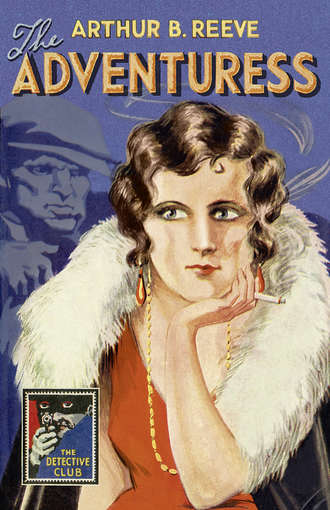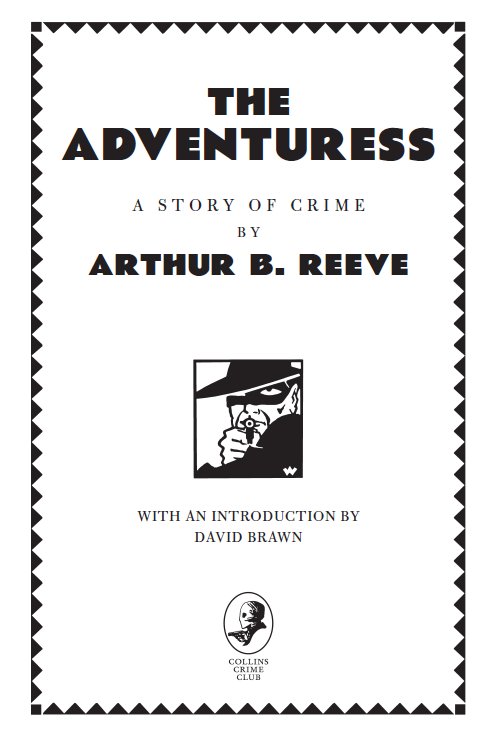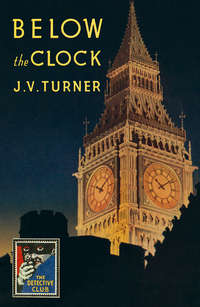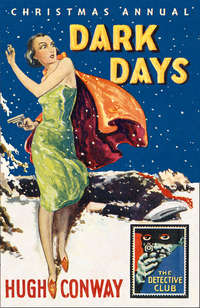
Полная версия
The Adventuress

‘THE DETECTIVE STORY CLUB is a clearing house for the best detective and mystery stories chosen for you by a select committee of experts. Only the most ingenious crime stories will be published under the THE DETECTIVE STORY CLUB imprint. A special distinguishing stamp appears on the wrapper and title page of every THE DETECTIVE STORY CLUB book—the Man with the Gun. Always look for the Man with the Gun when buying a Crime book.’
Wm. Collins Sons & Co. Ltd., 1929
Now the Man with the Gun is back in this series of COLLINS CRIME CLUB reprints, and with him the chance to experience the classic books that influenced the Golden Age of crime fiction.

Copyright
Published by COLLINS CRIME CLUB
An imprint of HarperCollinsPublishers Ltd
1 London Bridge Street
London SE1 9GF
www.harpercollins.co.uk
First published in Great Britain by W. Collins Sons & Co. Ltd 1918
Published by The Detective Story Club Ltd 1930
Introduction © David Brawn 2017
Cover design © HarperCollinsPublishers Ltd 1930, 2017
A catalogue copy of this book is available from the British Library.
This novel is entirely a work of fiction. The names, characters and incidents portrayed in it are the work of the author’s imagination. Any resemblance to actual persons, living or dead, events or localities is entirely coincidental.
All rights reserved under International and Pan-American Copyright Conventions. By payment of the required fees, you have been granted the non-exclusive, non-transferable right to access and read the text of this e-book on screen. No part of this text may be reproduced, transmitted, down-loaded, decompiled, reverse engineered, or stored in or introduced into any information storage and retrieval system, in any form or by any means, whether electronic or mechanical, now known or hereinafter invented, without the express written permission of HarperCollins.
Source ISBN: 978000813656
Ebook Edition © March 2017 ISBN: 9780008137663
Version: 2017-01-30
Contents
Cover
Title Page
Copyright
Introduction
Editor’s Preface
I. THE MYSTERY OF THE ‘SYBARITE’
II. THE SECRET SERVICE
III. THE CABARET DANCER
IV. THE BURGLAR’S MICROPHONE
V. THE WHITE LIGHT CAFÉ
VI. THE POISON GAS
VII. THE DIVORCE DETECTIVE
VIII. THE PULMOTOR
IX. THE TRAILING OF PAQUITA
X. THE DETECTAPHONE DETECTOR
XI. THE FRAME-UP
XII. THE EAVESDROPPERS
XIII. THE SERPENT’S TOOTH
XIV. THE GEOPHONE
XV. THE NIGHT OF TERROR
XVI. THE INVISIBLE INK
XVII. THE CIPHER LETTER
XVIII. THE RADIO DETECTIVE
XIX. THE WIRELESS WIRETAPPER
XX. THE SPEED DEMON
XXI. THE SUBMARINE EAR
XXII. THE TELAUTOMATON
XXIII. THE CURB MARKET
XXIV. THE PHANTOM CIRCUIT
XXV. THE ADVENTURESS
Footnote
The Detective Story Club
About the Publisher
INTRODUCTION
‘The name’s Kennedy. Craig Kennedy.’
The twenty-first century crime reader might be forgiven for replying, ‘Who?’ But a hundred years ago, Craig Kennedy, ‘scientific detective’, needed no introduction. He was a household name on both sides of the Atlantic, acquiring the impressive tagline ‘The American Sherlock Holmes’ and conquering newspapers, magazines, books, comic strips, stage, films—silent and spoken—and early television, destined, or so it seemed then, for literary immortality.
Kennedy’s creator, Arthur Benjamin Reeve, was born in the New York town of Patchogue on 15 October 1880. A gifted academic and polymath, he graduated from Brooklyn’s exclusive Boys’ High School in 1899 and went to Princeton University, studying ‘about everything with an ’ology or an ’onomy at the end of it’, inspiring and even tutoring fellow students. Law School beckoned, and although fascinated by the subject of criminal law Reeve had no appetite to compete when he discovered that there were 16,000 lawyers in New York and dropped out to pursue his first love: writing. Various editorial posts led to freelance journalism and some short stories, his first in Argosy magazine, before his big break came with Cosmopolitan in 1910.
Cosmopolitan, the magazine that had premiered H.G. Wells’ The War of the Worlds in the US in 1897, was at that time a monthly literary publication with nearly a million readers. Reeve’s story, ‘The Case of Helen Bond’, introduced Craig Kennedy, ‘the Professor of Criminal Science’, and was followed the next month by ‘The Silent Bullet’ (January 1911), which became the titular chapter of the first hardback when the first dozen stories were collected and published by Dodd, Mead in 1912. The adventures of Craig Kennedy were a constant monthly fixture in Cosmopolitan for two years before becoming less regular items, and more than 80 were published altogether by 1918.
The innovation of Reeve’s stories was that Kennedy, a chemistry professor based in New York, would apply scientific methods to the detection of crime. The fictional narrator was Walter Jameson, a newspaper reporter whose bemused interpretation of Kennedy’s wild experiments gave the reader’s eye view of events, recalling Sherlock Holmes’ Dr Watson. The stories contained more than a little science fiction, from developments in chemistry and medicine to speculative communication devices and weaponry, but these were not tales of fantasy: the scientific theories were perceptive and up to date. Reeve prided himself on keeping abreast of the science journals and plundered them for story ideas, with scientists like Tesla and Edison complimenting him on his technological intelligence, and readers thrilled at the possibilities that were envisioned in the Craig Kennedy tales. As John Locke observes in his invaluable biography, From Ghouls to Gangsters: The Career of Arthur B. Reeve (Off-Trail Publications, 2007), the inventions had mysteriously evocative names like the ‘vocaphone’, the ‘sphygmograph’ and the ‘optophone’, but Reeve was not a research scientist or a soothsayer of future-truth and did not restrict himself to hard sciences. He was writing detective stories, and it was his entertaining storytelling and mastery of the puzzle-solution structure that ensured his continuing popularity.
In addition to Cosmopolitan, Reeve wrote stories in the early years for McClure’s, Hearst’s, The Popular, The Red Book, Pearson’s and Adventure magazines, also creating new principal characters—Guy Garrick, an enlightened young detective who had studied criminal science, and Constance Dunlap, a relative rarity in 1913 being a woman detective. There were more books, all bind-ups of the short stories, although they began to be presented as novels, with additional linking material and chapter breaks to disguise the original short story format. The first full-length Craig Kennedy novel, The Gold of the Gods, was published in 1915 by Hearst’s International Library.
It was at this point that the movie industry, a fertile ground for dramatic writers with its requirement for cliffhanger serials, lured Reeve and his fictional brainchild to the silver screen. The Exploits of Elaine (1914), a formulaic follow-on from that year’s The Perils of Pauline, featured Craig Kennedy heroically deploying science against the menace of the villainous Clutching Hand. Two sequels swiftly followed, as did novelisations, which were published by Hearst’s in 1916 and separately in the UK by Hodder & Stoughton. Meanwhile, Craig Kennedy also made his stage debut, with the first play opening in Hartford, Connecticut, in 1915.
Despite a general curtailment in Reeve’s short story output during his film writing years, a new full-length novel commissioned by the respected New York publishing house Harper & Brothers was published in 1917 as part of their centenary year celebrations. The Adventuress, concerning a murder in a munitions firm and the theft of a new invention, the ‘telautomaton’, was serialised initially in the Chicago Examiner for, they claimed, ‘the highest price ever paid this author for a novel’. UK rights were sold to Harpers’ future sister company, William Collins, who also bought the final two collections of Cosmopolitan shorts, The Treasure-Train and The Panama Plot. Meanwhile Harpers went on to publish ten more books with Reeve, plus an impressive twelve-volume reprint collection, The Craig Kennedy Stories (1918), which included the bulk of the Cosmopolitan shorts (although not the newly released The Panama Plot), the novel The Gold of the Gods, the Elaine novelisations and the two non-Kennedy books, Guy Garrick and Constance Dunlap. The widespread success of this set at the time has ensured that the early Craig Kennedy books have remained relatively easy to track down, whereas The Adventuress and the novels that followed it remain generally much harder to find.
With his Cosmopolitan run having ended in 1918, the 1920s saw Reeve diversifying. More film work included writing for stage sensation Harry Houdini, with their first movie, The Master Mystery, also having the distinction of featuring the first on-screen robot, Automaton ‘Q’; he even wrote Westerns. A return to magazines, newspapers and lucrative pulps saw Craig Kennedy appearing in both cosier romantic mysteries and stories set in the country as well as harder-edged gangster stories and syndicated comic strips. Technology remained a constant theme—the film serial Craig Kennedy: Radio Detective (1926) capitalised on a very topical medium, and the novel Pandora (1926) featured synthetic fuel and an atomic bomb.
By the end of the decade Reeve was focusing more on real-life criminology. He became ‘radio detective’ himself when NBC signed him in 1930 to write and host Crime Prevention Program, an advisory series in conjunction with the NYPD. It rejuvenated his journalistic career: more radio followed, he published his first non-fiction book, The Golden Age of Crime, an examination of racketeering and other consequences of Prohibition since its introduction in 1920, and he covered high-profile crime cases in newspapers, including the Lindbergh kidnapping case that had inspired Agatha Christie’s Murder on the Orient Express (1934).
Reeve’s final novel, The Stars Scream Murder (Appleton-Century, 1936), was in terms of the science one of his least plausible—astrology!—and was also Craig Kennedy’s swan song. The flap of the dust-wrapper bore an enthusiastic summary of Reeve’s achievements since creating his scientific detective a quarter of a century earlier:
‘More than a million copies of Arthur B. Reeve’s “Craig Kennedy” books have been sold in the United States to date and almost as many in Great Britain.fn1 They have been translated into practically every language, including one book into ancient Korean.
‘The Stars Scream Murder, probably the first astrological detective novel ever published, maintains Mr Reeve’s long record of firsts. His first story employed the use of tire treads in detection, a method which has now borne fruit in the Federal Bureau of Investigation of the U.S. Department of Justice, with its astounding file of the treads of all tires manufactured. The first story ever to use the now well-known dictagraph was written by Mr Reeve even before the scientific journals had described it. He also wrote the first story based upon the Freudian theory and psychoanalysis. Pioneering in this manner, he has created a new type of detective story with a host of imitators. He himself considers his most important influence the helping along of the creation of a scientific department in every one of the country’s modern detective headquarters.
‘It is hardly necessary to recount the innumerable titles which have made his name a household word as a master of detective fiction, nor to recall his various motion picture serials, such as The Exploits of Elaine, The Master Mystery, Terror Island, etc., which so many of us remember. He was in radio in the days of its infancy, his N.B.C. Crime Prevention Program having achieved particularly wide attention.’
Arthur B. Reeve died just four months later, on 9 August 1936, of cardiac asthma, aged only 55. As John Locke wryly observes, ‘Reeve all but took Kennedy to the grave with him. Most of the books were already out of print; the remainder soon joined the silence. Reeve went from American institution to forgotten man of antiquity virtually overnight.’ The only reprieve was a 26-part television series starring Donald Woods, Craig Kennedy, Criminologist in 1952, although it was pretty generic and largely ignored the science angle that had distinguished the original Craig Kennedy from his peers.
Reeve had undoubtedly struck a chord with readers and had modernised crime fiction to make it feel relevant and exciting; but sadly nothing dates quite as quickly as yesterday’s cutting-edge science. Craig Kennedy now reads more like a parody than a visionary detective. But if you can transport your mind back 100 years, The Adventuress might still ‘unfold new delights to readers of exciting mysteries’, as the review in the London Globe newspaper maintained, and will hopefully inspire readers to investigate more of the forgotten work of Arthur B. Reeve and his ‘American Sherlock Holmes’.
DAVID BRAWN
October 2016
EDITOR’S PREFACE
To the real reader of detective fiction the name of Craig Kennedy must be almost as well known as that of Bulldog Drummond, or Sherlock Holmes himself. He has taken his place among the great crime investigators of our literature, not simply because he is the ‘hero’ of some of the world’s best mystery novels, but because he is distinctly an individual. His personality and his methods are his own, and except perhaps in his success as a solver of crimes he cannot be said to resemble any other detective hero. He is essentially the scientific sleuth; not only in his logic, but in the more melodramatic sense of the word—in his laboratory experiments.
Mr A. B. Reeve, the creator of Craig Kennedy, seems to be a very mine of ingenuity. He introduces into his stories strange cyphers, diabolical machines, subtle poisons, and a hundred and one new weapons for his murderer, but he never becomes cheaply sensational. His farthest flights of imagination appear rational to his readers, for he unfolds his story so cunningly and with such a conviction of truth.
At the present time, when the crime novel is at the height of its popularity and authors vie with each other in turning out more and more complex plots, it is refreshing to find someone like A. B. Reeve, who is content to entertain and mystify us without putting us through an examination in mathematics or psychology.
One need only read The Adventuress to test the truth of this assertion; it is of the author’s best and, unlike many of Craig Kennedy’s cases, is a full-length novel and not a short story; but the one admirable feature of an A. B. Reeve book is that it makes one forget office, household duties, everything one wants to forget, for several glorious hours in a new world of romance and mystery.
CHAPTER I
THE MYSTERY OF THE ‘SYBARITE’
A REVOLVER-SHOT followed by the crash of glass sounded in our hall.
At the same instant the laboratory door burst open and an elderly, distinguished-looking man stumbled in on us, his hat now off, his coat and collar awry, his hair rumpled, and his face wearing a dazed, uncertain expression, as though he did not yet comprehend what had so suddenly taken place.
‘My God!’ he exclaimed, gazing about in a vain effort to restore his dignity and equilibrium. ‘What was that? I hardly had my hand on the knob when it happened.’
A glance was enough to assure Kennedy that the man was unhurt, except for the shock, and in a moment he dashed out into the hall.
The front door of the Chemistry Building had been shattered by a revolver-shot. But not even the trace of a skulking figure could be seen on the campus. Pursuit was useless. There was, apparently, no one to pursue.
Pale and agitated still, the man sank limply into a chair as I forced a stimulant into his trembling lips.
Kennedy closed the door and stood there a moment, a look of inquiry on his face, but without a word.
‘Someone—must have—shadowed me—all the way,’ gasped the man as he gulped hard, ‘must have seen me come in—tried to shoot me before I had a chance to tell you my story.’
It was some minutes before our strange visitor regained his poise, and Craig refrained from questioning him, though I was consumed with curiosity to know the reason of his sudden entrance.
When at last he did speak, his first words were so different from anything I had expected that I could hardly believe him to be the same person. In spite of his nervousness, his tone was that of a hard, practical man of business.
‘I suppose you know something of Maddox Munitions, Incorporated?’ he inquired, somewhat brusquely.
I did not quite understand a man who could be himself so soon after an episode such as he had been through, nor do I think Kennedy did, either.
‘I have no interest in “war brides”,’ returned Craig coldly.
‘Nor have I—as such,’ the man agreed, apparently rather pleased than otherwise at the stand-off attitude Kennedy had assumed. ‘But I happen to be Maxwell Hastings, attorney for Marshall Maddox, who was—’
Kennedy wheeled about suddenly, interrupting. ‘Whose body was found floating in Westport Bay this morning. Yes, Mr Jameson and I have read the little five-line despatch in the papers this morning. I thought there was something back of it.’
As for me, I was even more excited now than Kennedy, and I could see a smile of satisfaction flit over the face of Hastings. In a few sentences the clever lawyer had extracted from us what others took all manner of time and art to discover. He knew that we were interested, that he could depend on Kennedy’s taking the case.
Kennedy and I exchanged a significant glance. We had discussed the thing cursorily at the breakfast-table as we did any odd bit of news that interested us.
Already I knew, or fancied I knew, something of the affair. For it was at the time when explosions in munitions plants had furnished many thrilling chapters of news.
All the explosions had not been confined to the plants, however. There had been and still were going on explosions less sanguinary but quite as interesting in the Maddox family itself.
There was a hundred million dollars as the apple of discord, and a most deadly feud had divided the heirs. Together they had made money so fast that one might think they would not feel even annoyance over a stray million here and there. But, as so often happens, jealousy had crept in. Sudden wealth seemed to have turned the heads of the whole family. Marshall Maddox was reported to have been making efforts to oust the others and make himself master of the big concern.
‘Maddox had had some trouble with his wife, hadn’t he?’ I asked, recalling scattered paragraphs lately in the papers.
Hastings nodded. ‘They were separated. That, too, was part of the family disagreement. His sister Frances, took the part of his wife, Irene, I believe.’
Hastings considered a moment, as though debating how far he should go in exposing the private affairs of his client, then caught the eye of Kennedy, and seemed to realise that as long as he had called Craig into the case he must be frank, at least with us.
‘At the Westport Harbour House,’ he added deliberately, ‘we know that there was a little Mexican dancer, Paquita. Perhaps you have heard of her on the stage and in the cabarets of New York. Marshall Maddox knew her in the city.’
He paused. Evidently he had something more to say and was considering the best way to say it.
Finally Hastings leaned over and whispered, ‘We know, too, that Shelby Maddox, his brother, had met Paquita at the Harbour House just before the family conference which brought them all together.’
It was evident that, at least to Hastings, there was something in the affair that looked ugly to him as far as Shelby was concerned.
‘It’s not at all strange,’ he added, ‘that two men as unlike as Marshall and Shelby should disagree. Marshall was the dominating type, eager for power; Shelby easy-going, more interested in having a good time. In this affair of Paquita—whatever it amounted to—I’m not at all surprised at Shelby. He is younger than Marshall was—and inclined to be a sport. Still, there was a vein of susceptibility in Marshall, too. There must have been.’
Hastings paused. Human frailties were out of his ken as a lawyer. Property he understood; passions, no. With him the law had been a jealous mistress and had brooked no rival.
‘It was on Shelby’s yacht, the Sybarite, was it not, that the tragedy occurred?’ ventured Kennedy.
It was a leading question and Hastings knew it. He drew in a long, contemplative breath as he decided whether he should consent to be led.
‘Yes—and no,’ he answered finally. ‘They were there on the yacht, of course, to agree to disagree and to divide the family fortune. Shelby Maddox went to Westport on the yacht, and it was so hot at the Harbour House that they decided to hold the conference on the Sybarite. Marshall Maddox and I had motored out from town. The sister, Frances, and her husband, Johnson Walcott, live on the other side of the island. They motored over, also bringing with them Johnson Walcott’s sister, Winifred, who stayed at the Harbour House. Johnson Walcott himself went ashore from the yacht early in the evening, having to go to the city on business. That was all right, for there was Bruce, the lawyer who represented Frances Maddox—I mean Mrs Walcott, of course. You see, I’ve known the family so long that I often forget that she is married. Shelby had his lawyer, also, Mr Harvey. That was the party. As for the tragedy, I can’t say that we know positively that it took place on the yacht. No. We don’t know anything.’
‘Don’t know anything?’ hastened Kennedy. ‘How’s that? Wasn’t the conference amicable?’
‘Well,’ temporised Hastings, ‘I can’t say that it was especially. The division was made. Marshall won control of the company—or at least would have done so if the terms agreed on had been signed in the morning. He agreed to form a syndicate to buy the others out, and the price at which the stock was to be sold was fixed.’
‘But did they dispute about anything?’ persisted Kennedy, seeing how the lawyer had evaded his question.
Hastings seemed rather to appreciate the insistence than to be annoyed by it. So far, I could see that the great corporation lawyer was taking Kennedy’s measure quite as much as Craig was doing the same by him.
‘Yes,’ he answered, ‘there was one thing that occasioned more dispute than anything else. Maddox Munitions have purchased a wonderful new war invention, the telautomaton—wireless control of submarines, torpedoes, ships, vehicles, aeroplanes, everything—the last word in the new science of telautomatics.








